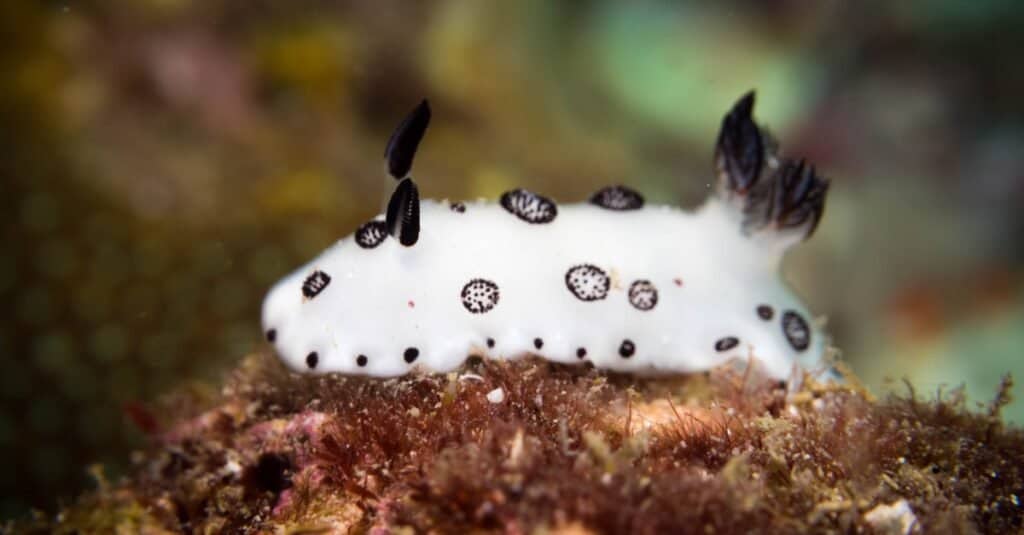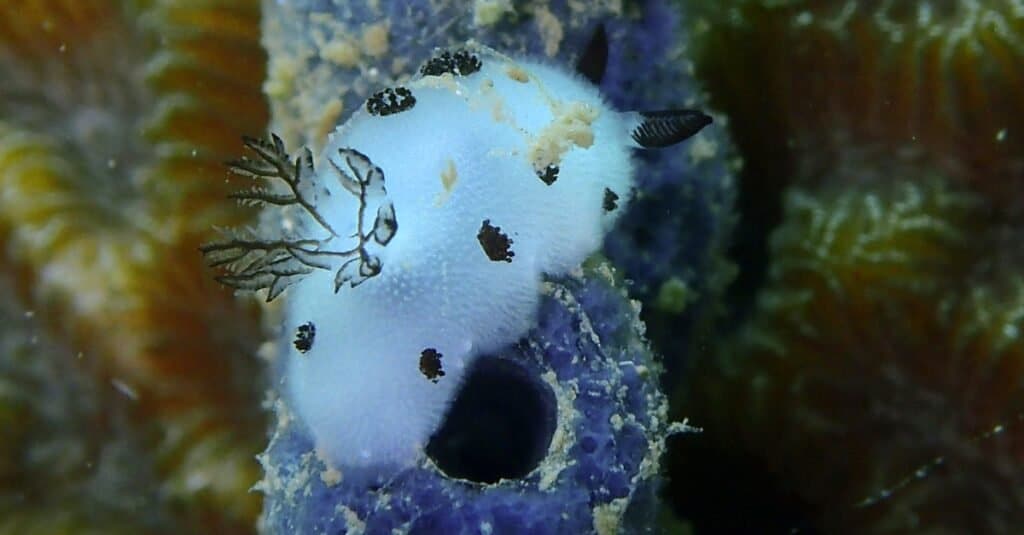Key Points:
- Native to the coastal waters between the Indian Ocean and Central Pacific, sea bunnies are cute, fluffy marine-based slugs that resemble rabbits. They are diverse organisms which can come is an assortment of exotic forms, dazzling colors, and odd features.
- The sea bunny is believed to begin its life in a shell, which is discarded before adulthood. Its coat is made of tiny rods called caryophyllidia, some of which end in black knobs, giving it a speckled appearance. Its two long antennae called rhinophores look like bunny ears. The sea bunny’s gills are located at the back of the slug, resembling a tail.
- Sea bunnies are born as hermaphrodites, able to produce both sperm and egg cells inside of their bodies. They still must find a mate to fertilize their own eggs in order to reproduce. Every parent is always the mother of her own children but the father of someone else’s.
Sea bunnies, whose scientific name is Jorunna parva, is a species of soft-bodied, shell-less, marine-based slugs. Although first described by Japanese zoologist Kikutaro Baba in the 1930s, these cute, fluffy, and wiggly little marine organisms rose to prominence on social media when people began to notice their remarkable resemblance to a rabbit. Measuring less than an inch long, they are native to the coastal waters between the Indian Ocean and Central Pacific. Its conservation status is not known, but it is presumably quite common.
The sea bunny belongs to a taxonomical order of sea slugs called the nudibranchs (itself a member of the gastropod class), which come in all kinds of striking colors, exotic forms, and weird accouterments. These are incredibly diverse organisms. Some slugs lumber forward on the seafloor in search of prey, while others swim through the water with an undulating motion.
The sea bunny itself varies between several different colors, including white, yellow, brown, and much less commonly, green. There is some scientific debate about whether these variations represent entirely different species or simple color morphs of the same species. The bunny-like white and black morph seems to mostly reside around the coastal waters of Japan. The rabbit-like gastropods have been found in Papua New Guinea, the Philippines, Réunion, Seychelles, and Tanzania.
Much like other slugs, the sea bunny is thought to begin its life with a shell and then shed it sometime before reaching adulthood. Any actual resemblance to a rabbit, including the white body and the long “ears,” is purely coincidental, but its appearance is nevertheless striking. The coat actually consists of tiny rods called caryophyllidia, some of which end in black knobs, giving it a speckled appearance. The “ears” are two long antennae called rhinophores with small flaps emerging from the sides.
Another important feature is the sea bunny’s gills. They are located on the backside of the slug instead of the front, emerging outward like a tail. This is a distinguishing feature of the nudibranch group called the dorids. In fact, the term nudibranch literally means naked gills. While there are many aspects of its physical characteristics and behavior that remain a mystery, the sea bunny is still a fascinating organism for both scientific study and general interest.
#3. The sea bunny’s body is basically one big sensory instrument

©Nual K/Shutterstock.com
As mentioned previously, the sea bunny is covered in all kinds of sensory organs that help it navigate in the water. The two antennae-like rhinophores emerging from the head are arranged in such a way as to maximize the surface area of the sensory receptors. Despite consisting of skin and nerves rather than fur, they appear particularly thick and fuzzy, like the ears of a rabbit. These antennae-like structures serve the purpose of detecting chemicals in the water and the direction of currents.
The caryophyllidia rods that cover the body like fur are likewise thought to play some kind of sensory role, although it’s not exactly known how. Given their density all around the body, they must be incredibly important for the slug’s survival. Together, they combine to serve as the slug’s main means of sensing the environment. The slug’s other senses are incredibly limited. The eyes are only able to see light and dark and not much else.
#2. The sea bunny is a hermaphrodite
Hermaphroditism, meaning the presence of both male and female sexual organs in a single entity, is a pretty uncommon occurrence as the main means of reproduction among vertebrates; most reptiles, mammals, birds, etc have well-defined sexes.
But gastropods, the sea bunny among them, are different. They are born hermaphrodites, capable of producing both sperm and egg cells inside of their bodies. This does not mean the sea bunny is able to self-fertilize, however. They still mate sexually by exchanging their sperm with another member of the species to fertilize their own eggs. If you thought human relationships are convoluted, then the family dynamics of the sea bunny has it beat. Every parent is always the mother of her own children but the father of someone else’s.
The hermaphrodite reproductive strategy is so common among gastropods and other invertebrates that it must offer them some advantages. One likely theory is that it arose due to the limited mate selection for slow-moving, low mobility animals like slugs and snails. It’s therefore very advantageous to mate with whomever the sea bunny comes across without worrying about the sex of the other individual. But the downside of this strategy is that sea slugs also need to consume a lot of extra energy because it’s actually quite expensive to continuously produce egg and sperm cells throughout their lives.
We don’t actually know a whole lot of details about the sea bunny’s mating process, but it’s thought to engage in a brief courtship dance, followed by a few minutes of actual copulation. The sea bunny has a long spine that digs into the partner so the two remain attached until the sperm exchange is over. This is assumed to be as painful as it sounds.
All mating opportunities must be condensed into the sea bunny’s short lifespan, which probably lasts for no more than a few months to a year. This means the sea bunny must mature quickly and reproduce as frequently as possible. Their well-developed sensory organs help them locate other sea bunnies in the wild. Unfortunately, their social behavior, to the extent that it exists, isn’t well-understood either.

©sutapat.t/Shutterstock.com
#1. Sea bunnies has highly potent toxins that may hold some benefits in cancer treatment
After losing its protective shell early in its life cycle, the sea bunny has only a single defensive mechanism to prevent it from being eaten. Fortunately, it’s a very good one: a highly potent toxin called macrolide B. What’s particularly interesting is that the sea bunny does not produce the toxins by itself. Instead, it acquires the toxin by consuming sponges in the natural course of its feeding. The sea bunny is apparently immune to the toxin, but the predator – not so much.
Once it has the unpleasant experience of ever eating a sea bunny, then the predator will think twice before trying again. Fortunately, this toxin may have interesting pharmacological applications. Scientists have known that it has the unusual ability to limit the spread of cancer cells in humans. Thus far, this has had limited clinical uses. Scientists are still trying to figure out how these toxins might be used to develop effective drugs that prevent cancers from metastasizing throughout the body.
Do Sea Bunnies Make Good Pets?
While some owners of saltwater aquariums attempt to keep a few varieties of sea slugs as pets, its a very challenging task, and is recommended only for experienced aquarists. The reason being, sea slugs have voracious appetites, and their required diet of prey species is very limited. Unfortunately, it’s easy to inadvertently starve them to death. And in the case of sea bunnies, they are not approved as pets because of their poisonous nature and the threat they would impose on other creatures in the aquarium habitat.
Summary
Sea bunnies might share a faint resemblance to rabbits, but that is where the similarity ends. These are saltwater sea slugs who prey on other sea creatures, particularly sponges. Give that their diet of sea sponges also makes them toxic to other animals, you certainly would not want to try to cuddle with sea bunnies. Those toxins might be useful in the fight against cancer someday, but that is a long way off. These cute critters are best left to left to themselves and enjoyed form afar.
Sea Bunny attributes:
| Attribute | |
|---|---|
| 1. | Highly toxic |
| 2. | Hermaphroditic |
| 3. | Covered in sensory organs |
Up Next…
- 10 Incredible Slug Facts Learn all kinds of interesting facts about the slimy slug in this enlightening article.
- Slug vs Snail: The 3 Key Differences Explained You may think the only difference between a slug and a snail is the absence of a shell. Read on to learn all of the distinctions.
- Are Spiders Insects? It’s easy to mistake a spider for an insect, but there’s some key differences that set it apart.
The photo featured at the top of this post is © phiseksit/Shutterstock.com
Thank you for reading! Have some feedback for us? Contact the AZ Animals editorial team.







